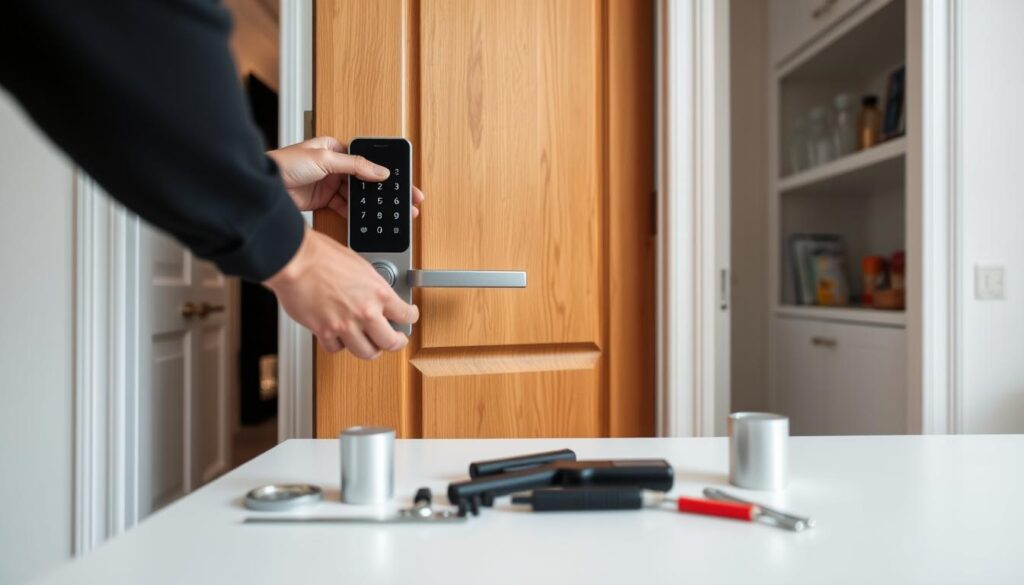Upgrading your traditional door lock to a modern keyless smart lock can significantly enhance both the security and convenience of your home. With the advancement in home security technology, eliminating the need for physical keys and enabling remote access capabilities, the question remains: are you prepared to take the leap?
The process of installing a keyless entry system is relatively straightforward, making it a feasible DIY project for most homeowners. By the end of this guide, you’ll not only understand how a smart lock can transform your home’s security setup but also gain the confidence to install one yourself.
Key Takeaways
- Enhance your home’s security with a modern keyless entry system.
- Understand the benefits of upgrading to a smart lock for your home.
- Learn the step-by-step process of installing a keyless smart lock.
- Discover how a smart lock can integrate with other smart home systems.
- Gain confidence in completing the installation as a DIY project.
Why Upgrade to a Keyless Smart Lock
Keyless entry systems are revolutionizing the way we secure our homes, offering unparalleled convenience and security. With the advancement in technology, these systems have become a viable alternative to traditional locking mechanisms.
Enhanced Security Features
Modern keyless smart locks offer significantly enhanced security features, including tamper alerts, auto-locking capabilities, and activity logs. Unlike conventional locks, many smart locks use advanced encryption technology to prevent unauthorised access attempts.
Convenience of Keyless Entry
The convenience of keyless entry cannot be overstated. You no longer need to fumble for keys in the dark or worry about lost or stolen keys compromising your home’s security. Smart locks integrate with your existing smart home system, allowing remote access via smartphone apps.
Remote Access and Management
Remote access and management capabilities enable you to lock or unlock your door from anywhere, receive notifications when someone enters your home, and check if you remembered to lock the door after leaving. Many systems offer customisable user profiles, perfect for families or homes that host guests.
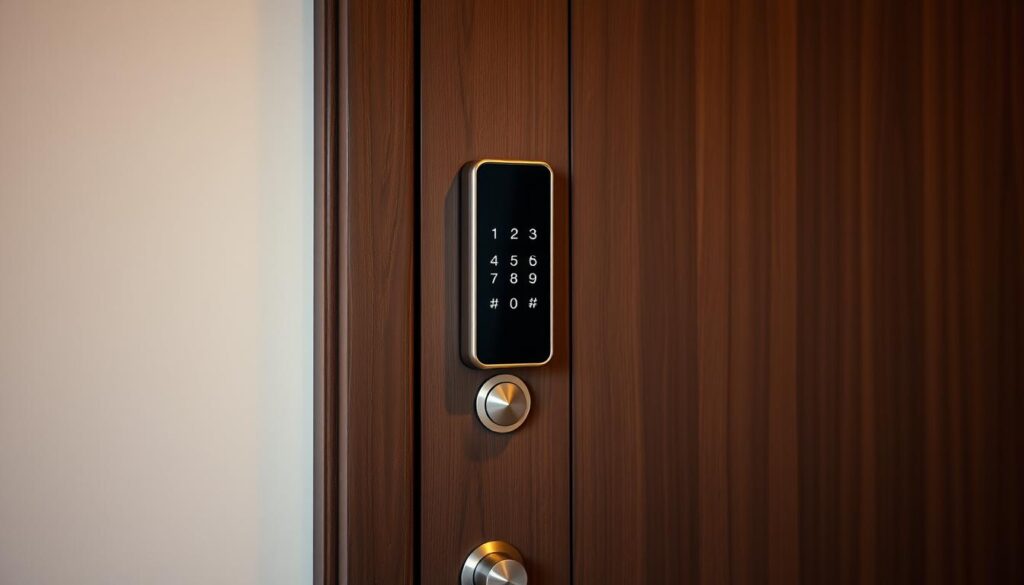
Choosing the Right Smart Lock for Your Home
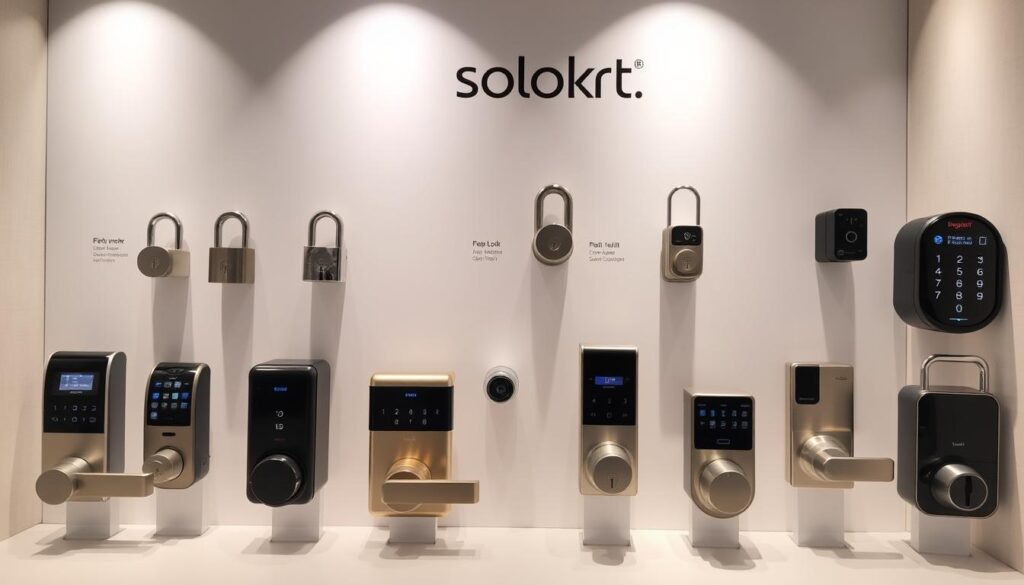
When it comes to enhancing your home’s security, selecting the right smart lock is crucial. With numerous options available, understanding the different types and their features is essential.
Types of Keyless Smart Locks
The most common keyless entry systems include smart locks, keypad locks, mobile-based access control, and biometric systems. Each offers unique benefits and varying levels of security.
For instance, keypad locks provide simple code entry without needing a smartphone, while biometric systems offer high security through fingerprint recognition, albeit at a higher cost.
Smart Home Compatibility Considerations
Ensuring your chosen lock is compatible with your existing smart home ecosystem is vital. Whether you use Apple HomeKit, Google Home, Amazon Alexa, or Samsung SmartThings, compatibility enables seamless integration and voice control.
Security Features to Look For
Essential security features include auto-locking functionality, tamper alerts, activity logs, and encryption standards. Additionally, consider locks with long battery life and backup entry methods in case of power failure.
By carefully evaluating these factors, you can select a smart lock that not only enhances your home’s security but also integrates well with your existing smart home system, providing convenience and peace of mind.
Tools and Materials You’ll Need
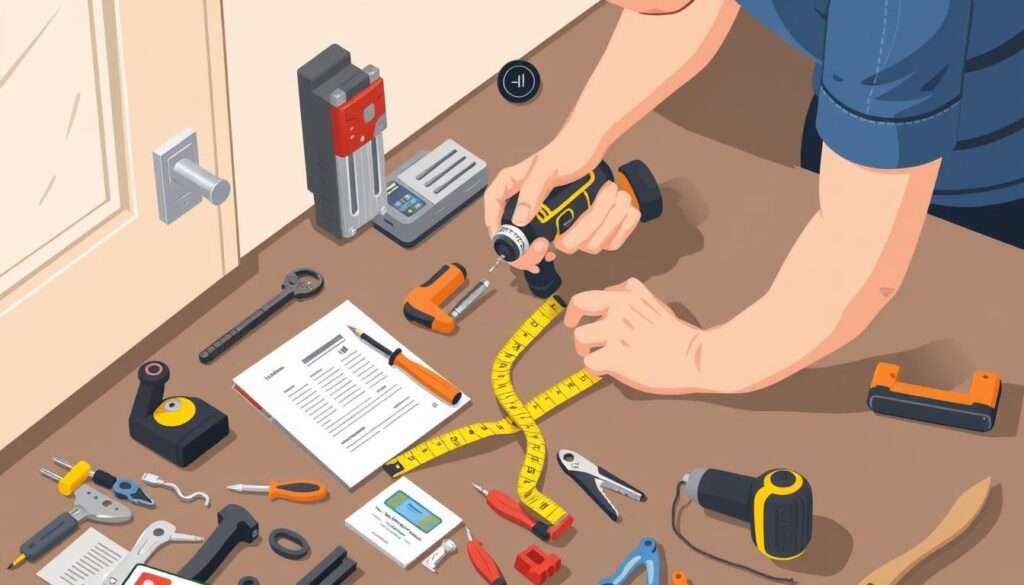
To ensure a smooth installation process, you’ll need to have the right tools and materials on hand. Most installations require only basic household tools that you likely already own.
Essential Tools for Installation
The essential tools for installing a smart lock include a Phillips screwdriver, a flathead screwdriver, a tape measure to verify dimensions, and potentially a chisel for adjusting the door frame if needed. Depending on your specific lock model and door configuration, you might also need a power drill with appropriate bits for creating new screw holes or enlarging existing ones.
Additional Materials That Might Be Helpful
Additional helpful materials include painter’s tape to hold components in place during installation, a pencil for marking positions, and a small container to keep track of small parts and screws. You may also need wood filler, sandpaper, or touch-up paint if your installation requires modifications to your door or frame.
Having a backup battery pack ready for your new smart lock can ensure you complete setup and testing without interruption. It’s also beneficial to have a second person available to help hold components during installation, making the process significantly easier.
Preparing for Installation
Proper preparation is key to a successful smart lock installation, starting with verifying your door’s compatibility. Before you begin, ensure you have all the necessary tools and information to complete the installation process efficiently.
Checking Door Compatibility
To verify your door’s compatibility, check its thickness, typically between 1⅜” to 2″, and measure the backset, commonly 2⅜” or 2¾” in the UK. Ensure your door closes and latches properly without sticking or requiring excessive force. Examine your existing lock and door frame for potential issues that might complicate installation.
Measuring Your Door and Lock
Take precise measurements of your door and existing lock setup. Measure the hole diameter for the lock body, typically 54mm or 2⅛”, and the edge bore for the latch, typically 25mm or 1″. For doors with separate deadbolts and handles, measure the distance between them to avoid interference with the existing handle.
| Measurement | Typical Size |
|---|---|
| Door Thickness | 1⅜” to 2″ |
| Backset | 2⅜” or 2¾” |
| Hole Diameter for Lock Body | 54mm or 2⅛” |
| Edge Bore for Latch | 25mm or 1″ |
Reading the Manufacturer’s Instructions
Thoroughly read the manufacturer’s instructions before beginning installation. Pay special attention to compatibility notes or warnings that might affect your particular door setup or existing smart home ecosystem. Consider taking photos of your existing lock setup before disassembly to serve as a reference if you encounter any difficulties during installation.
For more detailed guidance, you can visit Reolink’s smart door lock installation guide for additional tips and best practices.
How to Install Keyless Smart Lock: Step-by-Step Guide
Installing a keyless smart lock can seem daunting, but with the right guidance, it’s a straightforward process. This step-by-step guide will walk you through the installation process, ensuring that you can enjoy the benefits of your new smart lock without any hassle.
Removing the Existing Lock
The first step in installing your new keyless smart lock is to remove the existing lock. Start by unscrewing the interior portion of the lock, then remove the exterior portion, and finally, extract the deadbolt mechanism from the edge of the door. It’s essential to be careful during this process to avoid damaging the door or the lock components.
Installing the New Deadbolt and Strike Plate
Your smart lock kit should include a new deadbolt, strike plate, and hardware. Begin by securing the new deadbolt with screws in the top and bottom holes of the mounting plate. Next, add the strike plate, ensuring it aligns perfectly with the deadbolt when the door is closed. For longer screws, you might need to slightly drill the holes to accommodate them.
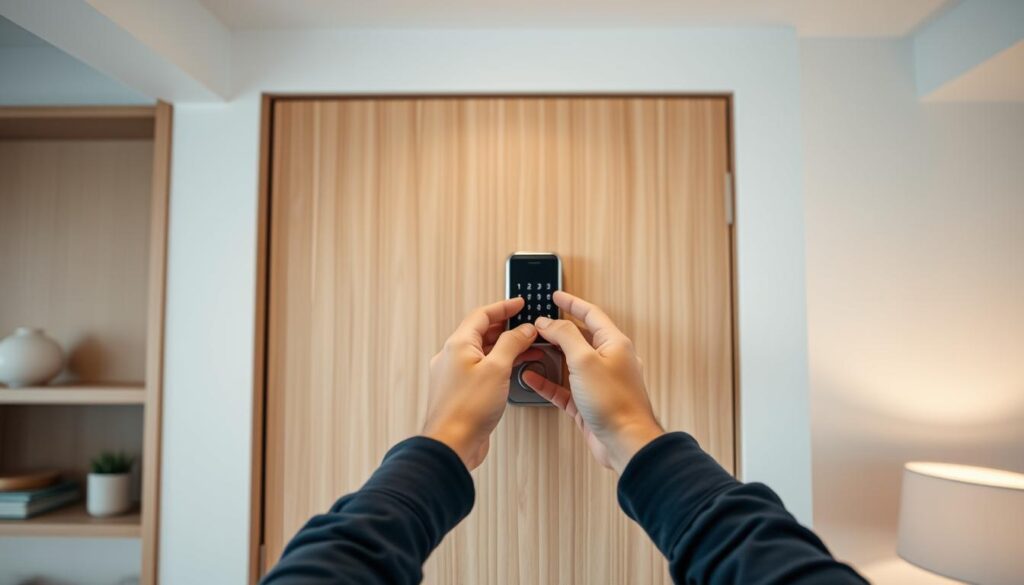
Mounting the Exterior Keypad
To mount the exterior keypad or touchscreen component, carefully feed any connecting cables through the door hole, then secure the exterior component against the door using the provided mounting plate or tape to hold it in place temporarily. Ensure the weather-resistant gasket is correctly positioned to prevent moisture from entering the lock mechanism.
Connecting the Interior Assembly
When connecting the interior assembly, carefully attach any cables from the exterior component, ensuring they’re not pinched or damaged during installation. Secure the interior mounting plate to the door using the appropriate screws. This step is crucial for the overall stability and functionality of your smart lock.
Installing Batteries and Testing Mechanical Operation
Finally, install the batteries according to the manufacturer’s instructions. Most smart locks use standard AA or AAA batteries that should last 6-12 months with normal use. Before proceeding to electronic setup, test the mechanical operation of the lock by manually turning the interior thumb turn to extend and retract the deadbolt, ensuring smooth operation without binding or excessive resistance.
By following these steps, you’ll be able to successfully install your keyless smart lock and enjoy enhanced security and convenience.
Setting Up and Programming Your Smart Lock
With the physical installation complete, the next step is to set up and program your smart lock using the manufacturer’s mobile application, which serves as the control centre for your new device.
Downloading the Mobile App
Begin by downloading the appropriate mobile app from the App Store or Google Play Store—the specific app will be indicated in your smart lock’s instruction manual and often accessible via a QR code included in the packaging. For instance, if you’ve purchased a Kwikset smart lock, you can find detailed instructions on their official support page: Kwikset Electronic Support.
Connecting to Wi-Fi or Bluetooth
The app will guide you through connecting your smart lock to your home’s Wi-Fi network or directly to your smartphone via Bluetooth, depending on the lock’s connectivity capabilities. For Wi-Fi connected locks, ensure your home network is stable and the lock is within good range of your router to prevent connectivity issues that could affect remote operation.
Creating Access Codes and User Profiles
Once connected, the app will allow you to create and manage access codes for the keypad, set up user profiles for family members or regular visitors, and establish temporary access codes with specific time limitations for occasional guests. Many smart lock systems allow you to name each access code or user profile, enabling you to track who is entering your home and when—a valuable security feature for monitoring household activity.
Testing Remote Access Features
Test all the remote access features thoroughly, including locking and unlocking the door from your phone, receiving notifications when the door is locked or unlocked, and viewing the access history log. If your smart lock integrates with other smart home systems, take time to set up these connections through the app.
Below is a summary of the key steps and features to configure your smart lock:
| Feature | Description | Benefit |
|---|---|---|
| Mobile App | Control centre for your smart lock | Remote access and monitoring |
| Wi-Fi/Bluetooth Connectivity | Connects lock to your home network or smartphone | Flexible access options |
| Access Codes | Create and manage codes for users | Customisable access control |
| Remote Access | Lock/unlock door remotely, receive notifications | Enhanced convenience and security |
By following these steps and exploring the features of your smart lock, you can enhance your home’s security and enjoy the convenience offered by this advanced technology.
Conclusion: Enjoying the Benefits of Your New Smart Lock
Having successfully installed your keyless smart lock, you can now enjoy a more secure and convenient way to manage access to your home. Your new smart lock eliminates the vulnerabilities associated with traditional keys, replacing them with encrypted digital access. You’ll quickly appreciate the convenience of keyless entry in your daily routine—no more searching for keys or worrying about locking yourself out.
Take full advantage of your smart lock’s remote access capabilities by setting up notifications for door activity. This keeps you informed about who is entering your home and when, even when you’re away. Consider exploring advanced features like auto-locking and geofencing to further enhance your home’s security.
Your smart lock can serve as the foundation for expanding your smart home system. Remember to periodically check for firmware updates to ensure you have the latest security enhancements and features. By doing so, you’ll maximise the benefits of your smart lock installation, enjoying enhanced security, convenience, and remote management capabilities.
